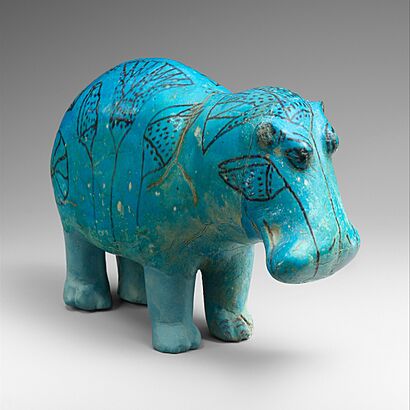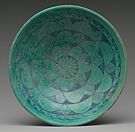William the Faience Hippopotamus facts for kids
Quick facts for kids Standing Hippopotamus |
|
|---|---|
| "William" | |
 |
|
| Year | c. 1961 BC – c. 1878 BC |
| Medium | Egyptian faience |
| Dimensions | 11.2 cm × 7.5 cm × 20 cm (4.4 in × 3.0 in × 7.9 in) |
| Location | Metropolitan Museum of Art, New York City |
| Accession | 26.7.898 |
William, also known as "William the Hippo," is a cool hippopotamus statue. It's made from a special material called Egyptian faience. You can find William at the Metropolitan Museum of Art in New York City. He's even an unofficial mascot for the museum!
This statue was found in an ancient tomb in Egypt, near a place called Meir. It's super old, from around 1961 BC to 1878 BC! That was during the time of Egyptian kings Senusret I and Senusret II. William is about 20 cm (8 inches) long. He's popular because he looks friendly and shows us a lot about ancient Egyptian art.
William is one of many items found in the tomb of "The Steward, Senbi." These items were bought by the Metropolitan Museum in 1917. The museum said William is a great example of animal statues found in Middle Kingdom tombs. He's also a perfect example of Egyptian faience. You can see William in Gallery 111 at the Metropolitan Museum of Art in New York City.
Contents
What is Egyptian Faience?
Egyptian faience is a special material that looks a bit like glass. It's made from crushed quartz powder. This powder is covered with a shiny, glass-like layer. Faience is softer and more flexible than real glass. This meant artists could shape it by hand or use molds. They made bowls, statues, and other objects.
Faience and glass use similar ingredients, like crushed quartz or sand. But faience doesn't have the same strong crystal structure as modern glass. Both materials were used to copy expensive gemstones. They were loved for their beauty and how long they lasted. Even though faience doesn't have clay, it's often thought of as a type of pottery.
Why Were Hippo Statues Important?
This statue shows how important different art styles were in ancient Egyptian burials. Animal figures were common during the Middle Kingdom. Hippo statues, often decorated with water plants, likely stood for the life-giving power of the Nile River. They might have had a religious meaning too. Sometimes, they were linked to a god named Seth.
Not all hippo statues from this time were painted in detail. That makes William very special! He is covered with black lines of lotus flowers, buds, and leaves. These designs show his home in the Nile's wetlands. The hippopotamus was a dangerous animal for ancient Egyptians. To keep the deceased safe in the afterlife, three of William's legs were likely broken on purpose. The museum later fixed these legs.
How William Got His Name
In the early 1900s, a man named Captain H. M. Raleigh and his family owned a photo of the hippo statue. They started calling him William. Raleigh wrote an article about the hippo for a magazine called Punch in 1931. In the article, he said, "He is described on the back of the frame as 'Hippopotamus with Lotus Flowers, Buds and Leaves, XII Dynasty (about 1950 BC), Series VII, Number i, Egyptian Faience;' but to us he is simply William."
This article was printed again in the Metropolitan Museum of Art's Bulletin in 1931. After that, the name "William" stuck! In 1936, the Met even released a book called William and his Friends: A Group of Notable Creatures in the Metropolitan Museum of Art. Since then, William has appeared in museum logos and on merchandise for both kids and adults. The Met started selling copies of William in the 1950s.
Images for kids





